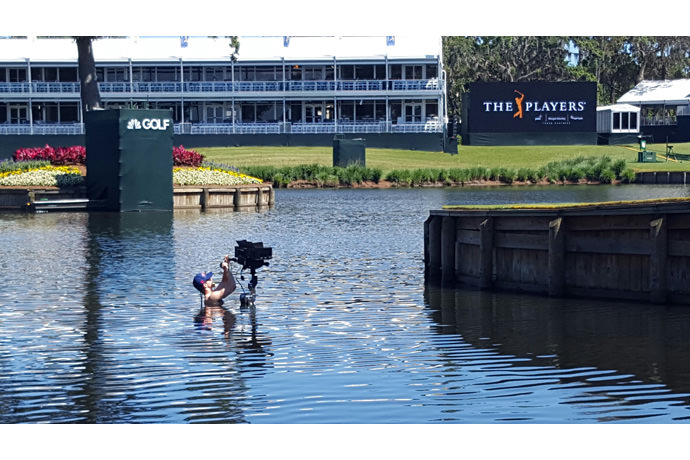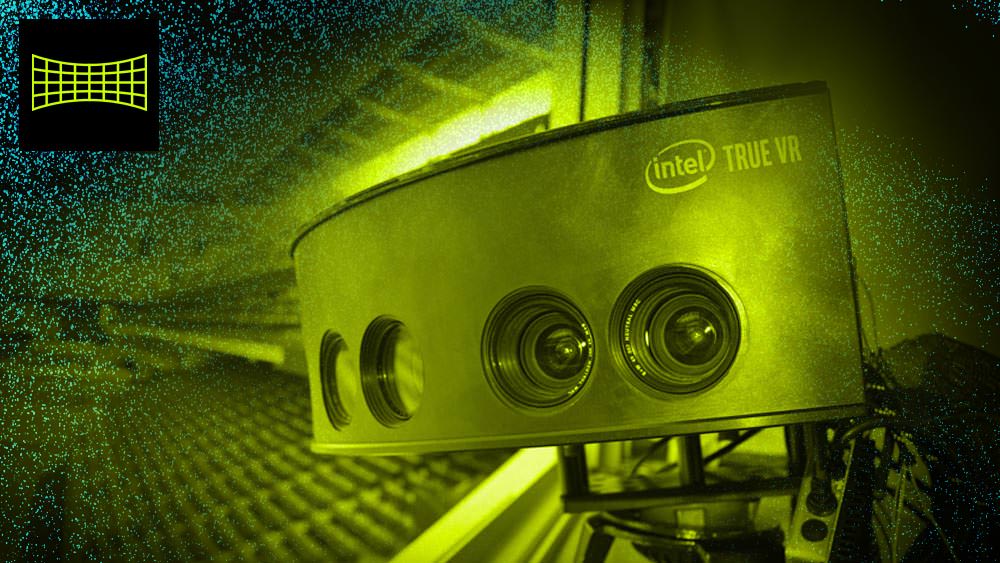Virtual reality technology is impacting practically all forms of entertainment in various ways, including video games, music, film and television. However, the area where the technology may have the biggest impact is with live events such as musical performances, awards shows and sporting events. Users can livestream these events in VR and feel as if they’re there in person, and the virtual nature of the experience opens up numerous opportunities for marketers and advertisers.
Intel has been a strong proponent of VR on multiple fronts, from gaming to sports. The technology company used the first year of its three-year partnership with MLB to test the flexibility of the Intel True VR platform by integrating different components into the fan experience. These include features such as real-time stats, pitcher and batter data, exclusive commentary and additional camera angles that leverage the unique features of each ballpark to deliver an in-stadium feel.
Intel also collaborated with the PGA Tour during the summer and strategically placed VR cameras in the water near the iconic 17th hole at TPC Sawgrass to capture the drama. In September, Intel and the PGA announced that they’d continue the collaboration and expand their VR coverage.
Similarly, Mandt Media (formerly Mandt VR) specializes in creating VR and AR content for partners such as Disney, the Pittsburgh Steelers of the NFL and IndyCar. Founded by Emmy Award-winning producer Neil Mandt, the media company has brought events such as the World Hip Hop Dance Championship finals to VR in partnership with Hip Hop International.
AListDaily sat down with Sandra Lopez, vice president of Intel Sports, and Neil Mandt, CEO and founder of Mandt Media, to discuss the marketing opportunities livestream events have in VR, and the best ways for brands to take advantage of it.

How would you say VR livestreaming compares to traditional livestreaming?
Lopez: In many ways, a VR sports livestream resembles a traditional sports broadcast. We have broadcasters for play-by-play and color commentary, and users have access to the traditional displays and statistics they’ve known their whole lives. At the same time, however, VR delivers a more immersive experience—whether as supplemental to the traditional viewing experience or as a way to bring the stadium experience to those who can’t be there in person. Short of buying a ticket and attending a game, this is the closest you can come to sitting courtside or on the 50-yard line. VR allows the fan from all parts of the world to feel what it’s like to be on the field or court from the best seat in the house.
Mandt: I look at it in a number of ways, because VR is something in the goggles. When you have it on, you’re having a VR experience. However, while a lot of brands and companies that are doing VR livestreams—a majority of their audience can’t watch them using goggles. They’re watching on mobile phones as a 360-video. So, the opportunity is great, but the brands need to consider what the ultimate distribution is going to be for the content. They need to consider the end user experience. Distribution in VR is complicated right now; the Oculus Rift, HTC Vive, Samsung Gear VR and PlayStation VR don’t all talk to each other, but all mobile phones do.
How can brands and events benefit from VR livestreaming?
Lopez: Consumers are demanding more immersive experiences. According to a study by Greenlight VR, 71 percent of consumers agreed that brands that sponsor VR events are forward thinking and modern. Brands that adopt VR will not only continue to be relevant with their target audience, but will also have the opportunity to more deeply engage with their consumers. VR is a tremendously inclusive and immersive experience, and one that enables brands to draw a global audience into an intimate, VIP setting. From product launches, to conferences to big games, consumers care about experiencing important events live, and VR offers a novel way for brands to connect with their existing audience in a personalized setting while reaching a new group of consumers that can’t attend an event in person.
Mandt: You have a bigger pallet to play with. In a 2D world, you would only have that specific view. As a 360-degree piece of content, you have the entire sphere to play with. So, there are opportunities to put your brand’s marker within the content in an organic way that’s non-intrusive, but allows for a continuous viewing throughout the piece. Right out of the gate in VR, a lot of people are using the bottom [floor] to put a plate with the brand logo on it. That may be too much for some people, and they may decide to put it on the side or the back, but you have a bigger sphere to play with just to put your logo. So right there, your brand presence can be in the piece in a softer way.

What can brands do in VR that can’t be done on a 2D screen?
Mandt: VR offers a periphery that does not exist in the 2D screen we’re used to looking at. The floor beneath you is a new area. It’s not something that you’re used to looking down at in a 2D experience, and a logo at the bottom is less intrusive to your storytelling than it would be behind you or to your side because it’s not in your normal field of view, it’s in your periphery. Putting it there does not affect the story but allows for engagement. It’s also layered on the internet, so it’s clickable using eye gaze to activate it. This is going to become more common as augmented reality takes over.
What would you say is the difference between a live VR experience and pre-recorded ones?
Lopez: Like any live event, a live VR experience is naturally unpredictable and requires a full production team to ensure everything runs smoothly. Pre-recording a VR experience eliminates many of the variables inherent to a live broadcast, but ultimately, the technical quality of the VR experience is the same. The main difference is simple—sports is best consumed live. Highlights look tremendous, but the thrill of a live game can’t be beat.
Is there a difference in how a sporting event should be presented in a VR livestream compared to award shows?
Lopez: Whether you’re broadcasting a game or an awards show, it’s essential to consider the needs of your audience. Games require broadcasters, scoreboards, close-ups, wide-shots and replays. Awards shows have a different set of needs. At its core, the technology is the same, but there’s an artistry in tailoring a broadcast to fit a specific audience. It’s not dissimilar from the basic principles of storytelling—who is your audience, why should they engage with your brand and how can you deliver a compelling experience that is worth their time?
Mandt: Yes, because sporting events are complicated. I know people are excited about sports in VR, and I come from a sports background, so I certainly am too. But the biggest problem with VR is distance to subject. If you’re too far away—beyond 15 feet—it can get soft fast. If you look at that same content on a mobile phone, things get small—quickly. In sports, getting the camera close to the action is inherently difficult, like with baseball. You can’t zoom well in VR. Some cameras can, but the quality isn’t where it needs to be yet. Whereas other sports like IndyCar, the camera can be in the car, so you’re close to the action. As opposed to an awards show, where cameras can be close to the stage. You can place the cameras in an award show where they would be acceptable, wouldn’t be in the way, and give users a sense of presence. Obviously, the biggest difference between VR and 2D livestreaming is presence—where you’re immersed in the experience and have a sense that you’re there.

What kind of impact does VR livestreaming have on advertising?
Lopez: The advertising industry is super creative, and VR provides the opportunity to further expand upon their creativity. While VR is still in its early stages, the technology represents a new frontier of advertising. These are exciting times—brands and advertisers have the opportunity to work together to deliver immersive media experiences that will more deeply connect with consumers through exciting and personalized experiences.
Mandt: I think we’re in an equivalent time period to 1950s television in every respect. Not only is the storytelling new in VR, but the branding is new. If you go back to 1950s television, you have a lot of things that were wholly sponsored by brands, like the Texaco Star Theatre comedy hour starring Milton Berle. I think you’re going to see a continuation of that in early VR content, where the brand is present in being part of content. Their name will be associated with the content and they will look for content that’s organic to their story. Sometimes it will be branded content and other times not, as far as telling their specific story, but it will have an emotional connection to what they are at all times. I think you’ll see their names on things more in the coming years, similar to what we saw on TV.
How do you think VR livestreams can be further enhanced?
Lopez: Like any relatively new technology, VR experiences will continue to improve over time. Video quality will crystalize, headsets will shrink and as consumers continue to adopt VR, crucial feedback will enhance the user experience.
Mandt: I think we’ll see a combination of VR and AR coming together, where through eye gaze, you’ll trigger content. You’ll look over things like a Coke can, see that it’s triggerable and they’ll be activated. That will be enough for brands—simple looks. I think we’re going to quickly get past the plate on the bottom and you’ll see full-sphere with careful placements of their marks throughout it. I think that’s the way brands are going to do it. They’re going to make sure that the brand organically exists in VR and can be activated if a person looks at it. People will learn about the triggers, and they won’t look at them until they’re ready to commit. So, the whole time they’re watching a show, they’re aware that there’s another experience waiting for them when they’re ready. You’ll see a lot of eye-tracking data, where people will look at whatever the target is multiple times before they agree to engage with it and watch whatever that mystery content is. I think it’s a huge opportunity for brands to be front of mind for people as they’re watching content while not being distracting.
What should brands keep in mind if they’re interested in livestreaming events in VR?
Lopez: The most important thing to keep in mind is the user’s experience. Think—’if I was watching this, what would I want to see and experience?’ and work backward from that point. We’re striving to enhance the fan experience. Take our MLB VR broadcasts, for example—this summer we added our own VR commentators, picture-in-picture overlays, player cards and live stats. It sounds small, but it makes a huge difference for the fan. This technology is improving every day, and we’re excited about where it’s headed.
Mandt: Keep it simple. You don’t want to go crazy and negatively impact the story. You have to think about the way people are used to watching a story. While there is a 360-degree sphere, you have to keep in mind that most people are not in spinning chairs. They’re sitting down and anchored—their brains want to be anchored—so you shouldn’t make them unnecessarily move around. They’re going to use the periphery of VR for an enhanced experience, but the center focus of the story should still be in front of them, and they need to find an organic way for their brand to be activated within the normal sight line of what the viewer is experiencing.

